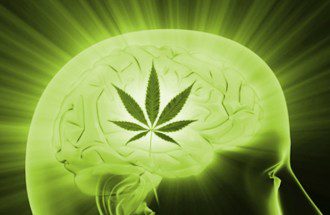Contributing Writer for Wake Up World
While a small minority has long been singing the praises of medical marijuana, until very recently it has been vilified by the mainstream. Portrayed as a dangerous, gateway drug that kills brain cells [1] and causes untold ills, this natural herb is slowly emerging from the cloud of propaganda and being seen in a more accurate light.
In the United States, cannabis has been criminalized at the Federal level by implementation of the Controlled Substances Act. This Act classifies cannabis, a natural herb, as a Schedule 1 drug—this is the strictest classification, on par with heroin, LSD and ecstasy. For a long time this rigid legislation meant that it was virtually impossible to conduct studies on it without breaking the law. Today the climate is slowly shifting and we are gradually seeing changes to some of the legislation that has long stifled research. While not much has changed at a federal level, at a state level legislation is being amended so that medical marijuana is no longer criminalized. Currently in the US, 21 states have legalised marijuana for medical purposes.
[pro_ad_display_adzone id=”110028″]
Now that there is some leeway, we are witnessing a growing body of evidence indicating a multitude of ways in which marijuana can benefit human health. Recent studies, as well as mounting anecdotal reports, suggest medical marijuana can assist with the treatment and management of many health conditions including cancer, seizures, glaucoma and multiple sclerosis.
One study that was recently published in the Journal of Pharmacotherapy looked at marijuana’s ability to help manage migraines.
Migraines are a debilitating condition characterized by a severe recurring headache, usually affecting only one side of the head, accompanied by sharp pain and often nausea, vomiting, and visual disturbances. Approximately 18% of women and 6% of men suffer from this dreaded affliction. Migraines are extremely painful and notoriously difficult to treat as regular pain-killers usually don’t work. Because most of the prescription medications for migraines are associated with serious adverse reactions and side-effects, a natural, gentler alternative would be most welcome.
According to a new study from researchers at the Skaggs School of Pharmacy and Pharmaceutical Sciences at the University of Colorado Anschutz Medical Campus, patients who had been diagnosed with migraine headaches saw a significant drop in their frequency when they used medical marijuana to treat their condition.
This study examined 121 migraine sufferers, who used medical marijuana to treat their condition between January 2010 and September 2014. The study documented an average reduction in migraines from 10.4 per month to 4.6 per month. This decline is considered to be both clinically and statistically significant.
Only fifteen of the 121 participants recorded no reduction in migraines, and three reported an increase.
“There was a substantial improvement for patients in their ability to function and feel better,” noted the study’s senior author Professor Laura Borgelt, PharmD, FCCP, BCPS. “Like any drug, marijuana has potential benefits and potential risks. It’s important for people to be aware that using medical marijuana can also have adverse effects.”
The study examined the charts of patients treated at Gedde Whole Health, a private medical practice located in Colorado. The clinic specialises in treating a range of conditions with marijuana. Approximately two thirds of the patients included in the study were either currently using, or had used cannabis in the past.
Of the various forms of cannabis being used, the researchers found that inhaled marijuana tended to be the favourite method for treating acute migraines. In terms of prevention, it was oral consumption, which is slower to impact on the body that was favoured.
While a distinct reduction in the number of migraines in participants was noted, more research is required to understand exactly how cannabis works in this process.
According to Borgelt, cannabinoid receptors are found throughout the entire body, including the brain, connective tissues and immune system. These receptors appear to have both anti-inflammatory and pain-relieving properties, and to affect important neurotransmitters like serotonin and dopamine, which are known to promote health and wellbeing in the body.
“We believe serotonin plays a role in migraine headaches, but we are still working to discover the exact role of cannabinoids in this condition,” Borgelt said.
Cannabinoids are a group of chemical compounds found in marijuana that are also known as terpenophenolic compounds. One of the most discussed cannabinoid compounds found in cannabis is tetrahydrocannabinol, often referred to as THC. This substance gives marijuana its psychoactive effects.
Another study, conducted by The Headache Center in Cleveland in 2015, reviewed randomized controlled research sources that estimate the role of cannabinoids in pain management. Concluding that cannabinoids have an empirically significant effect on pain mitigation, this review also offered a possible explanation as to why the use of cannabis can prevent headaches and migraines — the cannabinoids found in cannabis provide may an analgesic effect by modulating the pain signal in the brain on the level of the spinal cord.
Borgelt stated that while the findings of the Gedde study were “quite remarkable”, she emphasized the need for more controlled studies in the future:
“The ideal study would be a randomized, placebo-controlled clinical trial with a marijuana washout period prior to start. It would also require providing subjects with standardized quantities and potencies of medical marijuana while tracking the occurrence of migraines just like prescription drug studies. But given federal anti-drug laws, that kind of study would likely require legislative changes before it could be done.”
Because of the lack of control in this particular study, due to the federal legislation, it becomes difficult to quantify its findings in a meaningful or scientific way. This demonstrates that while the climate surrounding marijuana is shifting, there are still some serious legal hurdles to overcome if we want to see an abundance of high quality research in this area. While the ‘Reefer Madness’ style hysteria, which was fuelled by fear, ignorance, greed and racism and was used to inform the existing legislation is waning, these archaic laws are clearly still inhibiting real progress.
One of the industries that continues to lobby to maintain marijuana’s criminal status is unsurprisingly the pharmaceutical industry. With an aggressive, profit focused agenda it is clearly not in their interest to allow this plant with so many health benefits to become accessible to their potential or existing clients… unless, of course, they were able to control and profit from it. Also unsurprisingly, this is what many of them are scrambling to do. Cannaboid based products like, Sativex and Epidiolex are emerging, while further patent applications are being lodged. In fact even the US government, which still officially classifies marijuana as a dangerous drug, has filed a patent for medical marijuana.
Ultimately, while circumstances are looking more positive for genuine and extensive exploration of this plant’s potential, it is still far from being available to all who could benefit from it. Hopefully as the public comes to realise that marijuana has the potential to assist and alleviate the suffering of so many, we will see an irrepressible push to end the absurd existing laws that were created based on misinformation and half truths.
Notes:
[1] Rhesus monkeys were used in a study conducted in the US in the 1970s. The monkeys were forced to inhale the equivalent of 30 marijuana joints a day. The study found a clear relationship between marijuana consumption and permanent brain damage. The results of this study were used to support strict legislation around marijuana and fuelled the ‘war on drugs’. However, when this study was examined by a third party it was discovered that crucial information had been left out of the initial report. The key information was that the monkeys were forced to inhale the marijuana over periods of 3-5 minutes without breaking for oxygen intake. When these facts were taken into account it seemed that asphyxiation and carbon monoxide poisoning were more likely responsible for the results. When this study was repeated by independent research groups that addressed these concerns no brain damage was found.
References:
- http://www.eurekalert.org/pub_releases/2016-01/uoca-cas011416.php
- http://www.thenation.com/article/anti-pot-lobbys-big-bankroll
- http://www.art.net/~hopkins/Don/hemp/prohibition/no-clothes.html
- http://www.ncbi.nlm.nih.gov/pubmed/26015168
- https://www.psychologytoday.com/blog/your-brain-food/201309/marijuana-migraines
Further articles from Christina Lavers:
- 10 Signs You’ve Bought Spin
- New Study Shows Regular Contact with Nature Reduces Crime, Increases Social Cohesion
- Research Shows Just 7 Minutes of Meditation Can Reduce Racial Prejudice
- Taking Care of Our Inner Tribes – Microflora, Awakening and You
- Groundbreaking Study Maps the Decline of Wild Bee Communities in the United States
- Taking Responsibility For Our Energy
- More Evidence That TV is Dumbing Us Down
- Discernment – Navigating The Spiritual Minefield
- Synchrony and Exertion of Dancing Found to Encourage Social Bonding, Raise Pain Threshold
- Quitting Smoking? Try These Herbs, Tips and Incentives to Help You Succeed!
About the author:
Christina Lavers is a writer, an artist, a creative enthusiast, and an inner world explorer. Born in Montreal Quebec Canada, she now lives with her life partner and son in a rainforest pocket in the hills behind Coffs Harbour, NSW Australia. She spends her time playing, creating, growing and sharing.
Christina is devoted to assisting people to find and connect with their own creative magical current that flows deep within. She is now offering a comprehensive e-course designed to help people light up their world with passion and creativity. You can access Section One here for free!
Christina has also recently published her first full length book, a memoir about her wild awakening journey entitled Jump Into the Blue, and she is currently working on the next one.
“My journey has been about personal alchemy… exploring the mysteries of my soul and my environment, and learning to bring all aspects, the light and the dark, together with the transcending ingredient… love. The more I uncover and nurture the wounded aspects of my being, the more whole and grounded I feel and the more my outer world reflects the love, wonder and magic I have discovered inside”.
You can follow Christina’s work at:
[pro_ad_display_adzone id=”110027″]









